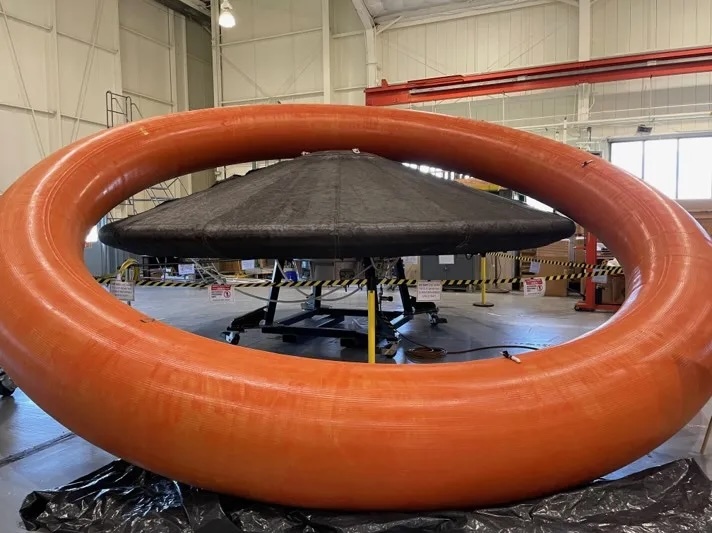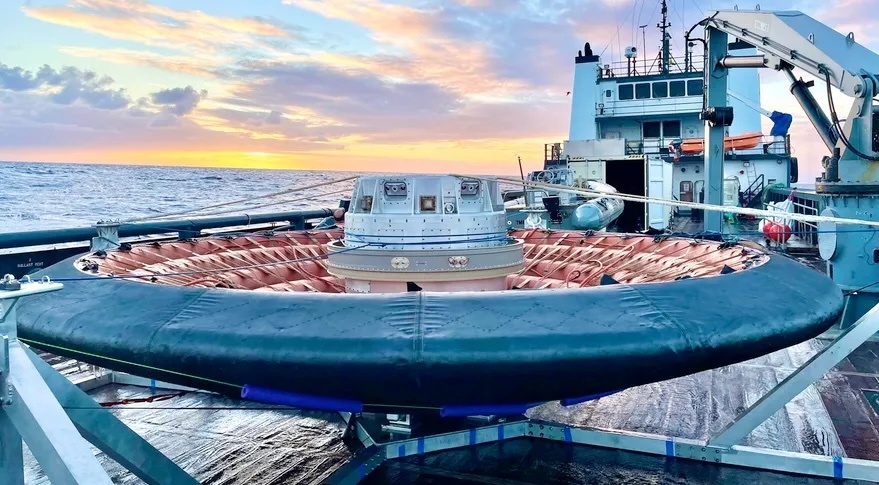1.08.2024

The first (and smallest) torus for the 10-meter aeroshell NASA is developing with ULA, sitting on top of the six-meter LOFTID aeroshell that completed its mission in November 2022. Credit: NASA
Space agencies are advancing inflatable heat shields they see as not only key for future missions to Mars, but also for unlocking fully reusable rockets and larger cargo deliveries back to Earth.
Since the dawn of the space era, rigid aeroshells have been the mainstay for safely returning people and cargo through the atmosphere with the aid of parachutes and retro propulsion.
However, they are limited by the shape of launch vehicle fairings and can be no more than four to five meters based on what is currently available.
“That four to five meters limits the amount of down mass you can bring back from orbit,” Joe Del Corso, project manager for the Low-Earth Orbit Flight Test of an Inflatable Decelerator (LOFTID) at NASA’s at Langley Research Center, said in an interview. “The bigger you can make the aeroshell during the re-entry phase, the more mass you can bring back from orbit.”
A four-to-five-meter rigid aeroshell using classic heat-resistant materials is suitable for returning up to one and a half metric tons from space.
Hypersonic Inflatable Aerodynamic Decelerator (HIAD) technology, on the other hand, can be compacted for launch, and then inflated to far larger sizes to protect spacecraft from burning up in the atmosphere.
A larger surface area increases drag, slowing down the spacecraft more effectively during re-entry, and this is particularly useful for a planet with a thin atmosphere such as Mars to ensure safe deceleration and landing.
“For us, we’re looking at going from one and a half metric tons to 20-40 metric tons,” Del Corso said.

more capable inflatable heat shields. Source: NASA
“One and a half metric tons is a well-instrumented golf cart. 20-40 metric tons is more like a small ranch house, fully furnished with a car in the carport.”
Inflatables are also generally lighter than rigids, leveraging flexible materials that enable them to conform to various shapes and sizes for a greater variety of payloads and missions.
But while traditional rigid heat shields like those used on SpaceX’s Dragon cargo transportation spacecraft are well-proven, it’s still early days for HIADs.
After launching on China’s Long March 5B rocket in 2020, an experimental Chinese cargo spacecraft with an inflatable, umbrella-shaped heat shield about three meters in diameter failed on its return to Earth.
Two years later, NASA’s LOFTID took off as a secondary payload on a United Launch Alliance Atlas 5 rocket, and successfully splashed down a six-meter HIAD — the largest blunt body aeroshell to ever go through atmospheric entry.
Europe enters the race
In June, Europe kicked off ICARUS, or Inflatable Concept Aeroshell for the Recovery of a re-Usable launcher Stage, which would culminate in 2028 with the return of a three-meter demonstrator after launching on a sounding rocket.
The European Commission recently awarded a consortium led by Deimos, the technology branch of Spanish contractor Elecnor, 10 million euros ($11 million) of funding for ICARUS.
Ali Gülhan, head of the department for supersonic and hypersonic technology at DLR, and principal investigator for ICARUS at the German space agency, said one of the main advantages of a foldable inflatable system is its compatibility with rockets and spacecraft already in use.
“Such inflatable aeroshells can be more easily integrated into existing launcher systems and used for heavy re-entry configurations,” Gülhan said.
DLR is responsible for the ICARUS launch campaign, flight test and the re-entry vehicle’s health monitoring system.
“In addition to several ground experiments to demonstrate or to verify the functionality of selected subsystems, a complete inflatable aeroshell payload will be tested in a ballistic flight with a two-stage sounding rocket configuration,” he said.
“The separation of the payload from the launcher and the deployment of the folded inflatable structure are critical events of the flight experiment.”
According to Deimos CEO Simone Centouri, the mission would set Europe up for testing a 10-meter shield that could help launchers bring back rockets for reuse, particularly for stages housing costly avionics and propulsion systems.
“If we have the possibility to reuse something [then] this is good because the impact of resources on Earth is lower,” Centouri continued, “and you can reduce your ecological footprint.”
NASA goes large
With a 1.1 metric ton re-entry mass, LOFTID withstood about 11.3 metric tons of drag load on the aeroshell during the November 2022 demo.
Since then, NASA has been “approached by a number of different companies and agencies looking to utilize the HIAD technology,” according to Del Corso.
United Launch Alliance has a Space Act Agreement with NASA to develop a larger inflatable heat shield for recovering BE-4 booster engines, which account for 65-70% of the cost of ULA’s next-generation Vulcan rocket.

NASA said the LOFTID test of an inflatable heat shield, seen here after recovery form the Pacific, was a success. Credit: NASA/Greg Swanson
SpaceX, which pioneered rocket reusability and has been regularly reusing first stages since 2017, has so far landed more than 300 orbital-class rockets after lift-off.
However, SpaceX can get away without HIADs for Falcon 9 and Falcon Heavy (which use the same boosters) because their first stage burns much shorter than conventional rockets, leaving the second stage to do most of the legwork to orbit.
ULA and other launch providers have beefier first stages.
“The bigger you make that first stage, the more propellant you have to have for that return trip,” Del Corso said, requiring a more sizable heat shield.
He said Vulcan’s engines would have around 23 metric tons of entry mass, putting 10 times that in aerodynamic loading on an aeroshell that would need a diameter of 10 meters.
“It’s a huge advancement in the HIAD technology,” Del Corso continued, “and it starts making it viable for things like bringing down pieces of the International Space Station or even sending humans to Mars.”
ULA’s first mission with the upgraded HIAD is slated for around 2026-2027.
It is “entirely possible” for heat shields to enable full rocket reusability, Del Corso added, but NASA has not received any approaches for that just yet.
“The challenge you’ve got with full first stage or even larger rockets is you get your center of gravity moving further and further backwards,” he said, making re-entry more unstable and challenging.
Next year, NASA plans to start working on leveling up the HIAD technology to accommodate more than 3.4 metric tons of drag load, involving a heat shield between 16 and 20 meters in size.
“That’s really the entry point for enabling human access to Mars,” Del Corso said.
Other organizations that have expressed interest in HIAD include the U.S. Department of Defense, although it is unclear whether the military would be a good fit.
“We decelerate really high in the atmosphere and we’re a giant, slow-moving target,” he added, “so that’s not really the best application for what they want to use. It’s better for folks who want to just bring down really large payloads.”
Alternative shields
Californian space technology startup Outpost, one of LOFTID’s partners, is looking to mechanically deployable heat shields for a business focused on returning small satellites and payloads from orbit.
HIADs are not for everyone, Outpost co-founder and CEO Jason Dunn said.
“They use materials that are expensive,” Dunn continued, and “there’s a variety of vendors and subcontractors that get involved when NASA builds one, so that adds in the cost.”
While HIADs work well for giant payloads, he said the technology gets bulkier when scaled down to around three meters in size.
“And the inflation system can be rather large,” he added, “so it’s harder to close the design case on a small scale.”
Outpost’s first mission is slated for 2026 when it aims to return a small, 200-kilogram satellite with a mechanically deployable heat shield the venture plans to mass-produce in-house.
The startup hopes to pioneer a new market for operators interested in reusing satellites that have completed their missions in low Earth orbit, rather than allowing them to vaporize as they fall back to Earth after running out of fuel.
Dunn said Outpost had also worked with NASA’s Ames Research Center on mechanically deployable heat shields, under the Adaptable Deployable Entry Placement Technology (ADEPT) program, before the space agency concentrated resources on HIADs.
“NASA has put a lot of funding into HIADs and I think that’s why we saw LOFTID be so successful,” he said, “and a lot of times the best technology is just the one that gets the most funding and gets developed out.”
As for LOFTID, Del Corso said NASA is working with the Smithsonian Institution to find its final home alongside other space industry firsts.
Quelle: SN
